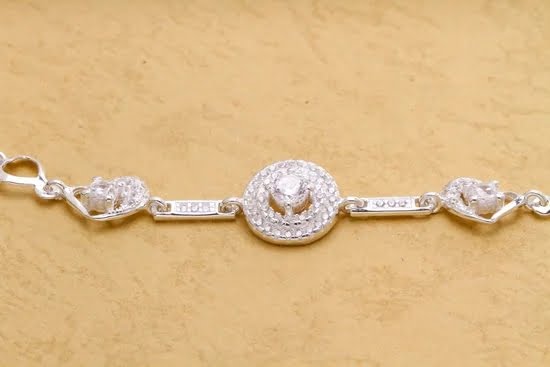The impact of World War II on jewelry design is a fascinating subject that delves into the transformative effects of global conflict on artistry and craftsmanship. Prior to the outbreak of WWII, jewelry trends were defined by opulence and intricate designs that mirrored the socio-economic milieu of the time. The pre-war era was marked by two significant artistic movements-Art Deco and Art Nouveau-that left an indelible imprint on jewelry styles.
In the years leading up to World War II, Art Deco reigned supreme with its bold geometric shapes, lavish use of gemstones, and an emphasis on symmetry. This style drew inspiration from various sources such as cubism, technology, and ancient Egyptian motifs particularly following the discovery of King Tutankhamun’s tomb in 1922.
Jewelry pieces often featured materials like platinum and diamonds, representing luxury and modernity. Meanwhile, Art Nouveau brought a contrasting aesthetic with its flowing lines, natural forms, and focus on craftsmanship; pieces from this movement frequently incorporated enameling techniques and semi-precious stones.
Both trends celebrated elegance and innovation, but their prominence provides a stark contrast to what was to come during WWII. As nations turned their resources towards the war effort, material shortages became rampant.
Precious metals like gold and silver were requisitioned for military purposes, forcing jewelers to pivot toward alternative materials such as plastics and base metals. These changes not only altered the physical properties of jewelry but also set in motion a stylistic shift driven by necessity more than fashion.
Materials and Resources During the War
Resource Rationing and Material Shortages
During World War II, the global conflict created significant disruptions in the availability of traditional jewelry materials. Precious metals such as gold and silver were heavily rationed, as they were redirected towards war efforts for manufacturing military equipment and supplies.
This scarcity forced jewelers to rethink their material choices, leading to innovative substitutes that forever changed the industry. The impact of World War II on jewelry design was notably marked by these shortages, as artisans turned to alternative materials like plastic and base metals, shifting the essence of jewelry from luxury to practicality.
Alternative Materials: Plastic and Base Metals
As traditional resources became limited, the use of plastics such as Bakelite surged in popularity within jewelry design circles. Bakelite’s versatility allowed designers to experiment with new shapes and colors that hadn’t been feasible before due to the restrictions on precious metals. Base metals like copper and brass also saw increased usage during this period.
These materials lent themselves well to mass production techniques which were necessary to meet both demand and wartime economy measures. The aesthetic shift towards simpler designs made with these humble materials speaks volumes about how resource constraints can drive creativity.
Impact on Jewelry Craftsmanship
The substitution of traditional luxury materials had a profound effect on the craftsmanship of wartime jewelry. With fewer precious resources at their disposal, craftsmen focused more on intricate detailing using available alternatives.
Techniques such as enameling gained prominence as a means to add color and vibrancy without relying on gemstones or rare metals. Additionally, this period saw an increase in hand-crafted pieces that emphasized personal significance over monetary value; items often bore patriotic symbols or sentimental motifs that resonated deeply with those facing uncertainty due to the war.
Stylistic Shifts
The impact of World War II on jewelry design marked a dramatic transition from opulent, intricate pieces to more streamlined and practical alternatives. Prior to the war, jewelry had been characterized by elaborate designs often embellished with precious stones and metals that emphasized luxury and status.
However, with the onset of the global conflict, these extravagant fashions began to wane in favor of pieces that embraced simplicity and functionality. This shift was driven not only by material shortages but also by changing societal values that placed practicality above opulence.
Due to stringent wartime austerity measures, many traditional resources such as gold and silver were redirected towards the war effort. In substitution, designers turned to more readily available materials like base metals and plastics. These alternatives allowed for the creation of durable yet aesthetically pleasing jewelry without draining essential resources needed for military purposes. As a result, wartime jewelry adopted a more minimalist aesthetic, focusing on clean lines and durable construction over lavishness.
Moreover, this era’s stylistic transformation was largely influenced by women’s shifting roles within society. With many men serving on the frontlines, women entered the workforce in unprecedented numbers, taking on roles that were previously deemed unsuitable for them. The functional needs of their new daily lives necessitated jewelry that complemented their working attire rather than hindered it. Hence, designs became more understated but elegant enough to be worn both at work and during off-duty hours.
| Material | Pre-War Use | Wartime Substitute |
|---|---|---|
| Gold | Common in luxury pieces | Base Metals |
| Silver | Used for intricate designs | Plastics |
| Precious Stones | Lavish adornments in high-end jewelry | Synthetic Gems & Simpler Ornaments |
In essence, World War II indiscriminately struck through all facets of life including fashion and personal adornments like jewelry. The demand for functionality combined with an evolving role for women precipitated a fundamental change in design philosophy-from extravagance toward elegance borne out of necessity. Even after the war ended, these practical influences continued to resonate within modern aesthetics and laid foundations for future trends adjusting perpetually around similar principles developed during this tumultuous period.
Patriotic and Sentimental Jewelry
Symbols of Patriotism
During World War II, jewelry not only served as a personal adornment but also became a medium for expressing national pride. Patriotic jewelry was widely popular and featured motifs such as flags, military emblems, and victory symbols. These pieces were often adorned with red, white, and blue gemstones or enamel to represent the allied nations’ colors.
The impact of world war ii on jewelry design can be seen in how these pieces aimed to boost morale and foster a sense of unity among the population. Brooches shaped like eagles, stars, and other American icons became more than mere accessories; they were statements of solidarity with those fighting overseas.
Sentimental Value
Lockets and brooches experienced a notable resurgence during this period, driven by the desire to keep loved ones close despite physical separation. Many soldiers carried photographs of their families inside lockets that hung around their necks or kept them in small brooches pinned to their uniforms.
Women on the home front also wore sentimental pieces featuring pictures or engravings of their husbands, sons, or sweethearts who were away at war. These items provided emotional solace during uncertain times and have since become treasured family heirlooms passed down through generations.
The Role of Personal Narratives
The demand for personalized jewelry grew significantly during WWII as individuals sought unique ways to express their personal stories amid global turmoil. Engraved messages, initials, or dates were commonly included in rings and bracelets, making each piece deeply meaningful to its wearer. This trend towards personalization helped maintain connections between soldiers abroad and their families back home.
In many cases, these sentimental tokens served as tangible reminders of love and loyalty amidst the chaos of war-a testament to the enduring human spirit even in times of great hardship. Through both patriotic themes and sentimental customization, the impact of world war ii on jewelry design has left an indelible mark that continues to resonate in contemporary styles today.
Influence of Technological Advancements
The impact of World War II on jewelry design significantly transformed the industry, with technological advancements playing a crucial role. One of the most notable changes was the shift toward mass production techniques. Before the war, jewelry was predominantly handcrafted, making each piece unique but also more time-consuming and costly to produce.
The necessities of wartime prompted industries to streamline their processes, which included adopting assembly line techniques from manufacturing sectors into jewelry production. This change allowed for the creation of intricate pieces at a faster rate and lower cost, thereby making jewelry more accessible to a broader audience.
Wartime technologies also introduced new materials that revolutionized jewelry design. Due to resource scarcity, traditional materials like gold and silver were often reserved for the war effort, leading designers to experiment with alternatives such as plastics and base metals.
Lucite and Bakelite emerged as popular substitutes for precious stones and minerals, offering an entirely new palette for creativity. These synthetic materials were not only cheaper but also versatile in textures and colors, enabling designers to explore innovative styles that had been unattainable with natural resources.
Technological innovations extended beyond materials to include advanced manufacturing methods such as electroforming and die-casting. These techniques enabled precise, consistent production of complex designs that would have been labor-intensive if executed by hand. For example, die-casting allowed for detailed replicas of filigree patterns or intricate motifs that mimicked high-end luxury items without the associated costs or labor. This technological leap democratized access to fashionable jewelry during austerity periods while reflecting practicality without sacrificing aesthetic appeal.
| Technological Innovation | Impact on Jewelry Design |
|---|---|
| Mass Production Techniques | Enabled faster and cheaper production of intricate pieces. |
| Synthetic Materials (e.g. Lucite, Bakelite) | Replaced scarce natural materials; expanded creative possibilities. |
| Electroforming & Die-Casting | Allowed precise replication of complex designs quickly and consistently. |
These technological advancements collectively changed the landscape of jewelry design during World War II. They facilitated both innovation in aesthetics through new materials and democratization by making elegant designs available to a wider range of consumers. Even in modern times, these advancements continue to influence contemporary trends in the industry, showcasing how necessity-driven innovation can leave an enduring legacy.
Post-War Economic Boom and Revival of Luxury
The end of World War II signaled the beginning of an economic renaissance, profoundly influencing various industries, including jewelry design. With the return of peace and a booming economy in the late 1940s and 1950s, demand for luxury items surged as consumers sought to celebrate life and prosperity following years of hardship. Jewelry makers responded by reviving pre-war opulence while integrating contemporary styles that reflected newfound optimism.
Key among post-war developments was the resurgence of high-quality materials such as gold, platinum, and precious gemstones. This shift marked a dramatic departure from wartime austerity measures when alternative materials like plastics and base metals were commonplace due to rationing.
The availability of premium resources enabled jewelers to craft elaborate pieces once again, reminiscent of pre-war art deco elegance but often with bolder designs and vibrant color palettes. In essence, jewelry became a statement of affluence and sophistication, proudly worn to signify one’s socio-economic status.
During this period, notable designers made significant contributions by blending classical influences with modern twists. They harnessed advancements in technology brought about by wartime research, embracing new techniques in mass production without compromising on craftsmanship quality:
- Cartier reintroduced their signature Tutti Frutti designs, now even more colorful thanks to post-war advancements in gemstone sourcing.
- Van Cleef & Arpels gained fame with their “mystery setting” technique which provided intricate details unseen before.
- Tiffany & Co. leaned into innovative marketing strategies that underscored luxury for middle-class Americans
These designers adeptly combined traditional elegance with fresh innovativeness influenced by the technological leaps witnessed during WWII. Thus, they played an instrumental role in shaping the aesthetic dynamics of mid-20th-century jewelry design.
Moreover, societal changes reflected in evolving gender roles also steered artistic expression within jewelry design during this era. The impact of world war ii on jewelry design included attention to women’s increased participation in both the workforce and social spheres. Accordingly, adornments became symbols not just of beauty but also empowerment and independence-a sentiment echoed through sleeker lines alongside embellishments befitting evening glamour or professional environments alike.
Jewelry pieces from this time enshrined individuals’ experiences within their aesthetics-whether it involved soldier sweethearts gifting lockets upon reunion or engagement rings symbolizing burgeoning hope for future generations-each item added layers rich in historical narrative beside its sparkling facade.
Notable Designers and Their Contributions
Renowned designers played a significant role in shaping jewelry trends during and after World War II, using their creativity to adapt to the limitations and challenges of the era. One such influential figure was Jean Schlumberger, who was initially known for his imaginative designs at Tiffany & Co. During the war years, Schlumberger served in the French Army, and upon returning, he brought a fresh perspective influenced by the austerity of wartime.
He often used unconventional materials due to shortages, incorporating items like glass and synthetic stones into his work, which resulted in a unique juxtaposition of luxury aesthetics with utilitarian elements.
Elsa Schiaparelli also stands out as a noteworthy designer whose work encapsulated the era’s spirit. Known primarily for her avant-garde fashion designs pre-war, Schiaparelli’s foray into jewelry during WWII reflected her ability to merge artistry with practicality. Her pieces often featured whimsical uses of Bakelite and other plastics that were more available than precious metals during the war.
This not only demonstrated ingenuity but also made high-fashion jewelry accessible to a broader audience affected by economic hardships. Moreover, Schiaparelli’s designs frequently included patriotic motifs such as stars and eagles, directly reflecting the impact of world war ii on jewelry design.
Another prominent name is Coco Chanel who redefined women’s fashion with her minimalist yet elegant aesthetic. During WWII, Chanel’s jewelry designs took on a simplistic yet sophisticated approach resonant with wartime austerity measures. She focused on creating costume jewelry that retained an air of luxury without relying on scarce materials like gold or platinum. This pivot not only provided women affordable elegance during tough times but also established costume jewelry as an enduring trend post-war.
- Jean Schlumberger
- Served in French Army
- Returned post-war with inspired designs
- Used unconventional materials like glass
- Elsa Schiaparelli
- Known for avant-garde fashion pre-war
- Utilized Bakelite and plastics during WWII
- Included patriotic motifs in her designs
- Coco Chanel
- Simplistic yet elegant approach
- Focused on costume jewelry
- Redefined luxury without using scarce materials
Cultural and Social Narratives Reflected in Jewelry Design
WWII wrought significant changes not just in logistics and economies, but also in cultural and social landscapes. The impact of world war ii on jewelry design is particularly evident when examining how wartime experiences shaped societal narratives encapsulated in personal adornments. Patriotism, for instance, became a crucial element reflected in jewelry designs.
Women wore pieces that featured national symbols such as eagle pins or enameled flag brooches, signifying support for their countries and soldiers abroad. These pieces were more than accessories; they were statements infused with deep emotional significance during a time of global turmoil.
The war also profoundly affected the socio-cultural fabric, particularly concerning gender roles and expectations. As men went to fight, women entered the workforce in droves, taking up roles previously deemed fit only for men. This shift is mirrored in the jewelry styles of the era.
Pre-war delicate designs gave way to sturdier and more practical pieces suitable for daily wear by working women. Jewelry had to be durable enough to withstand factory work or other labor-intensive jobs while still allowing women to express their newfound independence and evolving identity.
Additionally, post-war sentiments played a noteworthy role in jewelry designs that emerged after 1945. Upon returning from battlefronts or factories, people sought normalcy but carried with them a lingering sense of change brought on by wartime experiences.
Jewelry designers incorporated these feelings by creating pieces that referenced both past sacrifices and future hopes-items such as lockets containing photos of loved ones lost or victory-themed charms celebrating peace-time prosperity were incredibly popular. These elements provided comfort while acknowledging the shared collective experience shaped by living through WWII’s various hardships and triumphs.
Legacy of WWII Jewelry Design in Contemporary Trends
One of the most profound legacies of WWII on contemporary jewelry design is the integration of alternative materials. During the war, traditional precious metals and gemstones were scarce due to rationing and resource allocation for the war effort. As a result, jewelers turned to more readily available materials such as plastic and base metals, fostering a new era of creativity and innovation.
Nowadays, we see a resurgence in the popularity of unconventional materials like resin, wood, and even recycled elements in modern jewelry pieces. This shift not only reflects a continued appreciation for the resourcefulness necessitated by wartime conditions but also underscores current trends towards sustainability and ecological awareness.
Moreover, the impact of WWII on jewelry design can be observed in the minimalist aesthetic that gained traction during and after the conflict. The simplified designs born from necessity – eschewing excessive ornamentation for practicality – have resurfaced in today’s fashion-forward pieces.
Modern designers often draw inspiration from these historical roots to create sleek, understated works that emphasize form and function over flamboyance. This stylistic preference aligns with contemporary taste for versatility; minimalist jewelry can effortlessly complement both casual and formal ensembles, making it highly appealing to a broad audience.
Another enduring trend inherited from WWII is patriotic and sentimental jewelry. During the war, tokens featuring military insignias or national symbols became cherished mementos that held deep personal significance. Today, many contemporary jewelers revisit this concept by crafting bespoke pieces that hold sentimental value or symbolize cultural heritage.
Custom lockets bearing photographs or engraved messages are prime examples of how current designs echo wartime traditions. These personalized items provide wearers with an emotional connection to their jewelry, mirroring how soldiers’ family members might have treasured victory-inspired pins or charm bracelets during turbulent times.
By examining these trends through the lens of history, it becomes evident that while materials and aesthetics have evolved over decades, the impact of World War II on jewelry design endures as a testament to resilience and adaptability within this timeless art form.
Conclusion
The impact of World War II on jewelry design is a testament to the resilience and adaptability of human creativity during times of crisis. From the rationing of precious materials to the emergence of patriotic and sentimental motifs, the era’s hardships profoundly shaped jewelry aesthetics.
As discussed, pre-war opulence gave way to more practical designs out of necessity, reflecting broader societal shifts towards functionality and austerity. Innovations in technology further broadened the possibilities, introducing new manufacturing techniques and materials that have left a lasting mark on the industry.
Post-war prosperity reignited the market for luxurious items, bringing back gold, silver, and precious gemstones into popular use. The revival was not just a return to pre-war norms but an evolution influenced by wartime experiences-a blend of past opulence with newfound practicality. Designers who emerged or adapted their work during this period contributed significantly to this renaissance in jewelry design, creating pieces that encapsulated both tradition and modernity.
In contemporary trends, we continue to see elements rooted in the WWII era-the strategic use of alternative materials, minimalist styles juxtaposed with instances of lavishness, and emotionally resonant designs that tell personal stories. This enduring legacy underscores how periods of adversity can lead to profound artistic transformations, making it worthwhile for enthusiasts today to explore their collections or local stores for pieces with historical significance.
Sharing personal stories or heirlooms tied to this fascinating period adds depth to our appreciation of these small yet powerful artifacts from history.
Frequently Asked Questions
What Is the History of Ww2 Sweetheart Jewelry?
Ww2 Sweetheart Jewelry holds a special place in history as a symbolic form of affection and support during World War II. These items were commonly given by soldiers to their loved ones, including wives, girlfriends, mothers, and sisters, as tokens of love and remembrance while they were away fighting.
The jewelry often featured patriotic symbols such as flags, eagles, hearts, and insignias representing different military branches. Materials used for these pieces varied but frequently included sterling silver and inexpensive metals due to wartime rationing.
What Era Was the 1940s for Jewelry?
The 1940s was an era marked by notable transitions in the jewelry industry largely influenced by World War II. At the onset of the war, resources such as metals and gemstones were scarce due to rationing efforts aimed at supporting the war effort.
This led designers to innovate with alternative materials like wood, plastics (including Bakelite), and fabrics. By the mid-to-late ’40s post-war period, there was a resurgence in luxury goods’ availability and demand, leading to bold designs featuring large gemstones and intricate metalwork epitomizing glamour and new prosperity.
What Was the Impact of World War II on Women’s Fashion in the United States and Britain?
World War II had a profound impact on women’s fashion in both the United States and Britain. As men went off to fight, women entered the workforce in unprecedented numbers, necessitating practical yet stylish clothing suitable for factory work or office duties.
Utility clothing characterized by functional designs became widespread; garments had simpler cuts with less fabric use due to rationing regulations governing textiles production. Post-war fashion saw a dramatic shift as designers like Christian Dior introduced lavish styles—most notably through his famous “New Look”—that emphasized femininity with full skirts and fitted bodices using luxurious fabrics once more readily available after years of austerity measures.

Welcome to my jewelry blog! My name is Sarah and I am the owner of this blog.
I love making jewelry and sharing my creations with others.
So whether you’re someone who loves wearing jewelry yourself or simply enjoys learning about it, be sure to check out my blog for insightful posts on everything related to this exciting topic!





